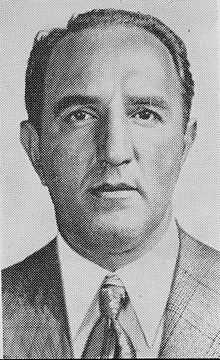Vincent Alo
| Vincent Alo | |
|---|---|
 Vincent Alo in 1950. | |
| Born |
May 26, 1904 New York, New York, U.S. |
| Died |
March 9, 2001 (aged 96) Florida, U.S. |
Vincent "Jimmy Blue Eyes" Alo (May 26, 1904 – March 9, 2001) was a New York mobster and member of the Genovese crime family who set up casino operations with mob associate Meyer Lansky in Florida and Cuba.
Early years
Born in Harlem, Alo started working on Wall Street at age 14. As a young man, Alo was convicted of armed robbery and sent to either Sing Sing or Dannemora state prison.
In 1926, Alo became a made man, or full member, of Joseph "Joe the Boss" Masseria's powerful New York gang. Named a caporegime of the old Joe Adonis crew, Alo oversaw clubs, speakeasys, and illegal gambling in Brooklyn.
Partnership with Lansky
In 1929, Lucky Luciano, one of Masseria's lieutenants introduced Alo to Meyer Lansky. An old friend of Luciano's, Lansky was a valuable money-maker for Masseria's organization and Luciano wanted Alo to guard him. However, Luciano may have wanted Alo to also monitor Lansky (a claim reinforced in Vincent Teresa's My Life In the Mafia and The Last Mafioso by Ovid Demaris). However the majority of crime historians view this as unlikely, as Lansky was at this time the head of a gang independent of Masseria and Luciano called the Bugs and Meyer mob, which made much of their income through extortion and was one of the most violent gangs of the era. Alo is described as a junior partner in Lansky's operations in virtually all sources, if mentioned at all. Both Lansky and Alo were introverted, bookish men who wanted to become legitimate businessmen. The two mobsters quickly became friends.
When Alo first met Lansky, Alo was involved in a setting up a casino in the town of Hallendale, Florida (now called Hallandale Beach). Immediately realizing that Alo would be perfect for this venture, Meyer invited him to become a partner. When Lansky and Alo arrived in Florida, they immediately started making contributions to local fraternal organizations and secret payments to politicians and law enforcement.
When they opened their first casino in Hallendale, Alo and Lansky faced no government or public opposition. Business was so good in the first casino that Alo and Lansky soon opened a second one in Hallendale. This cooperative relationship between the town and the mob would continue uninterrupted until 1947. As the town's economy became more diversified, public embarrassment about the illegal gambling increased. At that point, Alo and Lansky closed their two Hallandale casinos and started planning for casinos in Cuba.
Alo was also very active in Las Vegas. He was a partner with Moe Dalitz and Lansky in Wilbur Clark's Desert Inn. In 1985, after Lansky's death, Wilbur Clark introduced Alo as his "uncle" ("Gumba") or protector, and said that they could arrange certain benefits for businesses that needed help in Las Vegas. He continued his reading habits until his death and often talked about the books that Alo and his friends were reading in their book club in Hollywood, FL.
Later years

On March 9, 2001, Alo died of natural causes in Florida at age 96. His remains were interred in Woodlawn Cemetery in the Bronx.
In popular culture
The character Johnny Ola, portrayed by Dominic Chianese, in the film The Godfather Part II (1974) is based on Alo. The character Victor Tellegio, portrayed by Robert De Niro, in the film American Hustle (2013) is based on Alo as well.[1]
References
- Sifakis, Carl. The Mafia Encyclopedia. New York: Da Capo Press, 2005. ISBN 0-8160-5694-3
External links
- Vincent "Jimmy Blue Eyes" Alo at Find-A-Grave
- In Memory of Jimmy Blue Eyes website
- American Mafia.com Reprieve In Broward By John William Tuohy
| |||||||||||||||||||||||||||||||||||||||||
